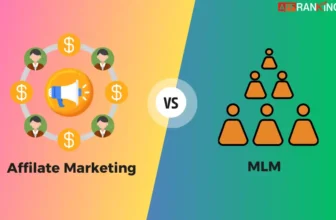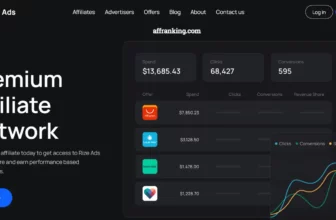Every business has its one, single strategy that actually defines it. Be it the marketing strategy, the planning, or the total dependability on the product, something is always the only thing that matters the most and makes the business distinguishable, and stand separate from others. And well oh well, in affiliate marketing, link-building remains a cornerstone of effective SEO strategy.
Today, let's discuss what De-Risking Link Building Strategies for US Affiliates is and at the same time also learn about the valuable insights and actionable steps to fortify your SEO game.
Analyzing Current Performance
Before you can improve your link-building strategy, it's crucial to understand your current performance. This involves analyzing your website's traffic, search engine rankings, and backlink profile.
Monitoring your website's traffic and ranking trends can provide valuable insights into the effectiveness of your current link-building efforts. For instance, a sudden drop in traffic or a decrease in search engine rankings could indicate a problem with your backlinks, such as a penalty for “black hat” SEO tactics or a high number of low-quality or spammy links.
There are several tools available that can help you monitor and analyze your website's performance. For example, Google Analytics can provide detailed information about your website's traffic, including the number of visitors, the pages they visit, and how long they stay on your site. This can help you understand which parts of your website are attracting visitors and which parts might need improvement.
In addition to monitoring traffic, it's also important to analyze your backlink profile. This involves looking at all the links pointing to your website to assess their quality and relevance. Tools like Ahrefs and Semrush can provide comprehensive analytics for your backlink profile, including a breakdown of the domains linking to your site, the anchor text they use, and the quality of the links.
These tools can also provide a toxicity score for your backlinks, which indicates the number of dangerous or spammy links pointing to your site. A high toxicity score can harm your search engine rankings and should be addressed as soon as possible.
By regularly analyzing your website's performance and backlink profile, you can identify potential issues before they become serious problems. This will allow you to make informed decisions about your link-building strategy and ensure that your efforts are effectively improving your website's SEO performance.
Understanding the Risks in Link-Building
Link-building is a critical component of any successful SEO strategy. It involves acquiring hyperlinks from other websites to your own, thereby driving referral traffic and increasing the authority of your site. However, like any powerful tool, link-building comes with its own set of risks and challenges.
One of the most significant risks in link-building is the temptation to resort to “black hat“ SEO tactics. These are strategies that violate search engine guidelines and include practices such as buying links, participating in link schemes, and using automated programs to create links. While these tactics might offer short-term gains in terms of increased traffic or improved search engine rankings, they can lead to severe penalties in the long run. Search engines like Google have sophisticated algorithms to detect such practices and can demote or even remove websites from their search results for using these tactics.
Another risk in link-building is the creation of “spammy” or low-quality links. These are links from websites that are not relevant to your content or are known for distributing spam. Having a high number of such links can harm your website's reputation and negatively impact your search engine rankings. It's important to remember that when it comes to link-building, quality trumps quantity. A few high-quality links from reputable and relevant websites are far more valuable than numerous low-quality links.
Finally, there's the risk of over-optimization. This happens when a website uses aggressive SEO techniques, like excessively using keywords or creating too many similar links, in an attempt to manipulate search engine rankings. Over-optimization can make your website appear unnatural to search engines and can lead to penalties.
Therefore, it's crucial to approach link-building with a clear understanding of these risks. The key to successful link-building lies in adopting “white hat” SEO tactics. These are strategies that adhere to search engine guidelines and focus on creating value for users rather than tricking search engines. By focusing on creating high-quality content, building genuine relationships with other websites, and earning links naturally, you can build a strong link profile that boosts your SEO performance and mitigates risks.
Identifying and Removing Spammy Links
As we mentioned in the article earlier, the spammy or harmful links can significantly impact your website's SEO performance. They can lead to penalties from search engines, resulting in lower rankings and decreased traffic. Therefore, it's crucial to identify and remove these links as part of your link-building strategy.
1. Identifying Spammy Links
Spammy links often come from low-quality or irrelevant websites. They may be part of a link scheme, such as paid links or link exchanges, or they may use over-optimized anchor text. Here's how you can identify them:
- Use a Backlink Analysis Tool: Tools like Ahrefs and Semrush can provide a toxicity score for your backlinks, indicating the number of potentially harmful links pointing to your site.
- Check the Quality of the Linking Site: Look at the domain authority of the linking site, its relevance to your content, and the context in which your link is placed. Low-quality sites, irrelevant sites, or sites that include your link in a spammy context may be a sign of a spammy link.
- Analyze the Anchor Text: Over-optimized anchor text, such as exact-match keywords, can be a sign of a spammy link. Natural backlinks usually have varied anchor text that includes branded keywords, generic terms, and a mix of exact-match and partial-match Keywords.
2. Removing Spammy Links
Once you've identified spammy links, the next step is to remove them. Here's how:
- Contact the Webmaster: The first step in removing a spammy link is to contact the webmaster of the linking site and request them to remove the link. This can be a time-consuming process, and not all webmasters will respond, but it's the most effective way to remove spammy links.
- Use Google's Disavow Tool: If you can't get a spammy link removed through direct contact, you can use Google's Disavow tool. This tool allows you to tell Google to ignore certain links when assessing your site's ranking. However, use this tool with caution, as incorrect use can harm your SEO performance.
By regularly identifying and removing spammy links, you can maintain a healthy backlink profile and avoid penalties from search engines. Remember, the goal of link-building is not just to increase the number of backlinks to your site, but to build a network of high-quality, relevant links that enhance your site's authority and drive valuable traffic.
Reviewing your Backlink Profile
Your backlink profile, the collection of all inbound links to your website, plays a pivotal role in your site's search engine ranking. Search engines like Google view each backlink as a vote of confidence in your content.
However, not all backlinks are equal. High-quality backlinks from reputable and relevant websites can significantly boost your SEO performance, while low-quality or spammy backlinks can harm your ranking.
Regularly reviewing your backlink profile allows you to assess the quality of your backlinks and identify areas for improvement. Here's how you can conduct a thorough review:
- Use a Backlink Analysis Tool: Tools like Moz provide comprehensive backlink analysis features. They can show you the total number of backlinks, the domains they come from, the anchor text used, and the overall quality of the links.
- Assess the Quality of Backlinks: Not all backlinks are beneficial. Links from low-quality or spammy websites can harm your SEO performance. Look at the domain authority of the linking websites, their relevance to your content, and the context in which your link is placed.
- Check for Link Diversity: A healthy backlink profile has a diverse range of links. This includes links from different domains, links to various pages on your website, and a mix of both dofollow and nofollow links.
- Analyze Anchor Text: The anchor text, the clickable text in a hyperlink, can give you insights into how other websites view your content. If the anchor text is relevant to your content and includes your target keywords, it can boost your SEO performance.
- Monitor Backlink Growth: Keep an eye on how your backlink profile grows over time. A sudden influx of backlinks, especially low-quality ones, can be a red flag for search engines and may lead to penalties.
This process ensures the backlink remains healthy and continues to support your SEO efforts. It also allows you to identify potential issues, such as an increase in spammy links, and take corrective action before they impact your search engine rankings.
Building a Healthy Backlink Profile
Building a healthy backlink profile is a critical aspect of de-risking your link-building strategy. It involves more than just removing harmful links; it requires earning high-authority and healthy backlinks that can enhance your website's credibility and improve its search engine ranking.
Here's how you can build a robust backlink profile:
Create Quality Content: High-quality, relevant content is the foundation of a healthy backlink profile. When you create content that offers value to your audience, other websites are more likely to link to it. This can include blog posts, how-to guides, infographics, research reports, and any other content that your audience might find useful.
Guest Posting: Guest posting involves writing articles for other websites in your niche. In return, you usually get a link back to your website. This can be a highly effective way to earn high-quality backlinks, increase your visibility, and establish relationships with other businesses in your industry.
Digital PR: Digital PR involves promoting your business online through press releases, social media, and other digital platforms. By creating newsworthy stories about your business, you can attract attention from news outlets and bloggers, who may link to your website in their coverage.
Building Relationships: Building relationships with other businesses, influencers, and bloggers in your industry can lead to more backlink opportunities. This can involve engaging with them on social media, commenting on their blog posts, or even reaching out to them directly to discuss potential collaboration.
Competitor Analysis: Analyzing your competitors' backlink profiles can provide valuable insights into potential backlink opportunities. If a website is linking to your competitors, they might be willing to link to you as well.
Building a healthy backlink profile is a long-term process that requires consistent effort. However, by focusing on creating quality content, building relationships, and earning high-quality backlinks, you can build a robust backlink profile that supports your SEO efforts and drives valuable traffic to your website.
Competitor Analysis
Understanding your competitors' backlink profiles can provide valuable insights into your own link-building strategy. By analyzing their content and the domains linking to them, you can identify potential opportunities for your own site and create content that attracts valuable backlinks.
Here's how you can conduct a thorough competitor analysis:
Identify Your Competitors: The first step in a competitor analysis is identifying who exactly your competitors are. These could range from businesses that offer similar products or services, rank highly for your target keywords, or have a similar audience.
Analyze Their Backlink Profiles: Once you've identified your competitors, you can use tools like Ahrefs or Semrush to analyze their backlink profiles. Look at the number and quality of their backlinks, the domains that link to them, and also the anchor text that has been used.
Identify Linking Opportunities: By analyzing your competitors' backlink profiles, you can identify websites that might be willing to link to your site as well. These could be blogs, news sites, industry directories, or any other sites that link to your competitors.
Analyze Their Content: Look at the content your competitors are creating that's earning them backlinks. What topics are they covering? What formats are they using? This can give you ideas for your own content.
Monitor Their Activities: Keep an eye on your competitors' link-building activities. Are they guest posting? Are they active on social media? Are they engaging with their audience? Understanding their strategies can help you refine your own.
Competitor analysis is not about copying your competitors' strategies, but about learning from them and exceeding more. By understanding what works for them, you can identify opportunities and strategies that can work for you.
Remember, the goal of link-building is not just to earn more backlinks, but to build a network of high-quality, relevant links that enhance your site's authority and drive valuable traffic.
FAQs on Link Building Strategies
What are the most effective link-building strategies?
The most effective link-building strategies involve creating quality content, building relationships, and earning high-authority backlinks.
Which link-building strategy works best in 2024?
In 2024, the best link-building strategy is to focus on earning high-authority and healthy backlinks through effective digital PR strategies.
What are the most common link-building methods?
The most common link-building methods include guest posting, creating engaging content, and building relationships.
What are the link-building strategies to get backlinks?
To get backlinks, focus on creating quality content that others find valuable, engaging with your audience, and building relationships with other professionals in your niche.
Conclusion
De-risking link-building strategies is not just about avoiding penalties; it's also about building a robust SEO foundation that drives long-term success for US affiliates. By understanding the risks, analyzing your performance, and building a healthy backlink profile, you can navigate the complex affiliate marketing landscape with confidence.
Also read 👉 Navigating the Competitive Landscape of Affiliate Marketing 🔥
From identifying and removing spammy links to building a robust backlink profile, every step requires careful planning and execution. Leveraging tools like Google Analytics, Ahrefs, and Semrush can provide valuable insights into your website's performance and backlink profile, helping you make informed decisions.
Moreover, understanding your competitors' strategies and learning from them can open up new opportunities for your own link-building efforts. Remember, the goal is not to replicate their strategies but to identify what works and adapt it into your own unique context.







